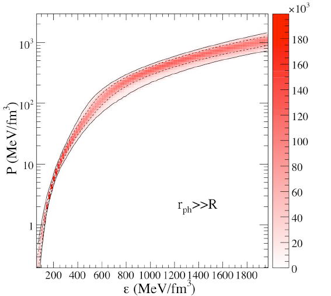
A dense matter equation of state (pressure as a function of mass-energy density) constructed from fitting a mass-radius curve to observations of photospheric radius expansion bursts and thermal emission from cooling transients. From Steiner et al. (2010).
An Empirical Dense Matter Equation of State
A long-standing goal of nuclear physics and astrophysics has been to determine the equation of state for dense matter—that is, the run of pressure with energy at super-nuclear densities. One can determine the equation of state by using it to construct a mass-radius relation for neutron stars and fitting that to available data. Steiner et al. used eight neutron star observations to obtain new constraints on both the mass versus radius curve and the equation of state. These include the low-mass X-ray binaries with photospheric radius expansion, which were used by Özel et al., as well as transient neutron stars that were observed in quiescence. The current data strongly suggests that the radius of a 1.4 solar mass neutron star lies between 10.4 and 12.8 km. The empirically determined equation of state is consistent with constraints from heavy-ion collisions, calculations of neutron matter using quantum Monte Carlo and calculations of neutron matter from effective field theory. This work is being extended to include the possibility of deconfined quark matter in the neutron star core.